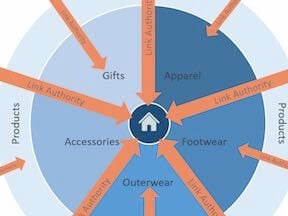Most ecommerce sites that perform well in organic search have jumped on the keyword URL bandwagon. Optimizing URLs to contain keywords is good for search engine optimization and also helps consumers recognize the content they’ll see when they click a link from search results pages.
Modern search engines can crawl any URL as long as it’s clearly linked to from another. Long URLs filled with many levels of directories and subdirectories, product and category numbers, and strings of parameters no longer represent technical challenges for search engines. But there are other reasons to optimize URLs with keywords.
The keywords in the URL send small relevance signals to search engines regarding the content of each page. In addition, because customers are more likely to choose a keyword URL in the search results, each click indicates that the page was indeed worthy of ranking and increases its likelihood of continuing to rank.
Basic SEO URL Structure
To clarify vocabulary, the image below illustrates a sample URL, from “Protocol” to “Subdirectory.”

A sample URL showing the different elements and their names: “Protocol,” “Subdomain,” “Domain,” “Top Level Domain,” “Directory,” and “Subdirectory.”
For the purposes of this article, I’ll be focusing on optimizing the path: everything that comes after Domain and Top Level Domain, or TLD.
URLs should contain only lowercase alphanumeric characters, with words separated by hyphens. They should be as short as possible — more for consumers’ readability than for search engines’ ability to index — and should remove every non-keyword directory possible. Parameters should only be used for tracking and sorting, not to load unique pages of content. Lastly, URLs should never be stuffed with unnecessarily repetitive keywords. Stuffing will not help you rank. But it will likely serve as a spam signal to search engines, and will decrease consumers’ ability to read the URL.
Keyword URLs and Category Structure
While optimal URLs should contain keywords, the tricky questions are “Which keywords to use?” and “How many keywords are too many?” The most practical way to determine which and how many keywords to include is to use the page names on the site to determine the directory and file names in the URLs’ paths. This is also the way that most platforms that offer keyword URLs as a feature will put URLs together by default.
For instance, if a site has a men’s category, a men’s clothing subcategory, and a men’s shirts subcategory under that, the path based on that sitemap and those page names could be like any these, below.
- /mens/mens-clothing/mens-shirts/
- /mens/clothing/shirts/
- /mens-clothing/shirts/
- /mens-clothing-shirts/
If you searched Google for the phrase “men’s shirts,” you would see all of these and more keyword URL structures ranking on page one. Which one is the best? They’re all acceptable. I’d prefer something like the third one — /mens-clothing/shirts/ — because it’s the least repetitive and easiest to read, but all four are fine.
Weigh what your platform can do — this will be the lowest cost solution — against the guidelines above. Any customizations to the URL structure will require some amount of development work. You’ll need to balance the cost of that work against the need to get the URLs to a more optimal state. If your URLs look like the first example above and it would take four hours of development time to get them to look like the third example, that’s probably worth the trade.
Keyword URLs and Products
When it comes to products, the URLs can get very long because the product names tend to be long. For example, your site might sell a men’s dress shirt like “Burberry London Seaford Trim Fit Dress Shirt,” product number 4729 in your product catalog. In addition to the product name, some ecommerce sites will require you to include the product identification number in the URL as the actual signal for which product content to load.
If you want to include path keyword information, together with the product name and number — and anything else the platform requires — it can result in ridiculously long product URLs. Some examples of product URLs could look like these.
- /mens/mens-clothing/mens-shirts/burberry-london-seaford-trim-fit-dress-shirt/4729/
- /mens-clothing/shirts/burberry-london-seaford-trim-fit-dress-shirt-4729/
- /mens-clothing/burberry-london-seaford-trim-fit-dress-shirt/4729/
- /p-4729/burberry-london-seaford-trim-fit-dress-shirt/
I prefer 3., because it’s the shortest while providing the default category and subcategory in which the product lives for added SEO and customer relevance.
However, some product names are vague and lack relevant keywords for SEO and for customer recognition. For example, “Single-Horn 150 lbs.” is the name of a blacksmith anvil product, but the product name doesn’t include that critical information. In cases where product names tend to be vague across the site, I might opt for the first product URL option: /mens/mens-clothing/mens-shirts/burberry-london-seaford-trim-fit-dress-shirt/4729/.
With over 200 factors in Google’s ranking algorithms, these are by no means the largest contributors to a site’s SEO success. But SEO is a discipline in which many small factors — and some very large ones — add up to create a much larger impact on performance than the value of a single smaller optimization on its own. In other words, the more optimizations you can put in place, the better chance you have of improving your place in rankings to drive additional traffic and sales.
When you’re redesigning or migrating a site to a new platform, optimizing the URLs as part of the process makes perfect sense. However, I do not recommend changing URLs as a standalone SEO tactic because the benefit it will bring on its own is not worth the upheaval it will cause your SEO performance in succeeding months. I addressed that topic, in fact, at “SEO Traffic Changes When URLs Change.”




